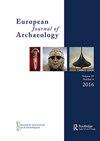Editorial
IF 1.4
2区 历史学
0 ARCHAEOLOGY
引用次数: 0
Abstract
With its twenty-sixth volume, the European Journal of Archaeology, enters a new era in its journey towards becoming a digital publication. After several years of discussion and a poll of EAA members in 2019 regarding their experience of the print journal, the EAA executive made the decision to go (mostly) digital as part of EAA’s commitment to sustainable practice. Print copies can be purchased, but are no longer included in membership by default. This move greatly reduces both plastic waste and air-miles associated with the journal’s production and dissemination, while also being a key step in the process of transforming EJA into a fully open access journal. We are undertaking this process with care and in close collaboration with our publisher Cambridge University Press, with the goal of creating an accessible (to both readers and all potential authors) and extremely high-quality journal for the twenty-first century. I am both proud and slightly intimidated to be the person at the helm, charged with navigating the EJA into its new future. In this issue of the European Journal of Archaeology, we feature six articles ranging from the Palaeolithic to the Early Medieval period and from Italy and Anatolia to Scandinavia and Ireland. García-Diez and colleagues start this issue with a new chronological interpretation of rock art from Las Chimeneas in Cantabria, Spain. On the basis of four new AMS dates, in combination with two older AMS dates and a contextual comparison of the Las Chimeneas panels with Iberian Palaeolithic portable and parietal art, they argue that the site’s art can be dated to the lower Magdalenian, 19,000-17,500 BP. Although four dates is not many, the authors make clear the value of combining AMS and stylistic data to date rock art; and, moreover, they convincingly argue that the future of rock art chronologies lies in the transparent exegesis of the process and materials used to date these types of sites. Shifting several millennia into the future, Haughton brings us to Early Bronze Age Britain and Ireland where he investigates the funerary rites at a number of different sites to argue that people in these areas had diverse locally significant and culturally contingent gender systems. He suggests that ideas of homogeneous Bronze Age social conformations, including gender, developed by archaeologists based on a Central European core region, can be productively challenged with outlier data from social and geographical margins, such as Britain and Ireland. Indeed, to my mind, he returns us to an important broader debate: to what extent are funerary practices useful for the reconstruction of living societies in the past? Dardeniz brings us on a tour of salt production and use in Bronze Age Anatolia. She productively synthesizes archaeological, textual, ethnographic, and geographic data to reconstruct the production and circulation of salt in the third and second millennia BC to hypothesize its role in the various political economies of the time. She argues that, in European Journal of Archaeology 26 (1) 2023, 1–2编辑
随着第26卷的出版,《欧洲考古杂志》进入了一个迈向数字出版物的新时代。经过几年的讨论,并在2019年对EAA成员进行了一项关于他们对印刷期刊的体验的调查,EAA高管决定(主要)采用数字化,作为EAA对可持续实践的承诺的一部分。可以购买打印副本,但默认情况下不再包含在会员资格中。这一举措大大减少了与期刊生产和传播相关的塑料废物和航空里程,同时也是将EJA转变为完全开放获取期刊的关键一步。我们正在与出版商剑桥大学出版社密切合作,小心翼翼地进行这一过程,目标是为21世纪创建一本可访问(读者和所有潜在作者)的高质量期刊。作为掌舵的人,我既自豪又有点害怕,负责引导EJA进入新的未来。在本期的《欧洲考古杂志》中,我们精选了六篇文章,从旧石器时代到中世纪早期,从意大利和安纳托利亚到斯堪的纳维亚和爱尔兰。García-Diez和同事们从对西班牙坎塔布里亚的Las Chimeneas的岩石艺术的新的时间顺序解释开始这个问题。根据四个新的AMS日期,结合两个更早的AMS日期,以及将Las Chimeneas面板与伊比利亚旧石器时代的便携式和顶板艺术进行背景比较,他们认为该遗址的艺术可以追溯到下马格达拉纪,19,000-17,500 BP。虽然四个日期并不多,但作者明确了将AMS和风格数据结合起来确定岩石艺术年代的价值;此外,他们还令人信服地认为,岩石艺术年表的未来在于对这些遗址的年代测定过程和材料进行透明的注释。几千年后,Haughton将我们带到了青铜时代早期的英国和爱尔兰,在那里他调查了许多不同地点的丧葬仪式,认为这些地区的人们有不同的地方意义和文化上的性别制度。他认为,考古学家基于中欧核心地区提出的青铜时代同质社会结构(包括性别)的观点,可以用来自社会和地理边缘(如英国和爱尔兰)的异常数据来有效地挑战。事实上,在我看来,他把我们带回了一个重要的更广泛的辩论:葬礼的实践在多大程度上对重建过去的生活社会有用?达德尼兹带我们参观了青铜时代安纳托利亚的盐生产和使用。她富有成果地综合了考古、文本、人种学和地理数据,重建了公元前三千年和公元前二千年盐的生产和流通,并假设了盐在当时各种政治经济中的作用。她认为,《欧洲考古杂志》26 (1)2023,1 - 2
本文章由计算机程序翻译,如有差异,请以英文原文为准。
求助全文
约1分钟内获得全文
求助全文
来源期刊

European Journal of Archaeology
ARCHAEOLOGY-
CiteScore
3.40
自引率
6.70%
发文量
58
期刊介绍:
The publication organ of the European Association of Archaeologists, the European Journal of Archaeology seeks to promote open debate amongst archaeologists committed to a new idea of Europe in which there is more communication across national frontiers and more interest in interpretation. The journal accepts not only new empirical data and new interpretations of the past but also encourages debate about the role archaeology plays in society, how it should be organized in a changing Europe, and the ethics of archaeological practice. All periods are covered; papers, review articles, interviews and short "debate" pieces are all sought. Whilst English is the primary language of publication in the EJA, papers submitted in French or German will be given equal consideration.
 求助内容:
求助内容: 应助结果提醒方式:
应助结果提醒方式:


